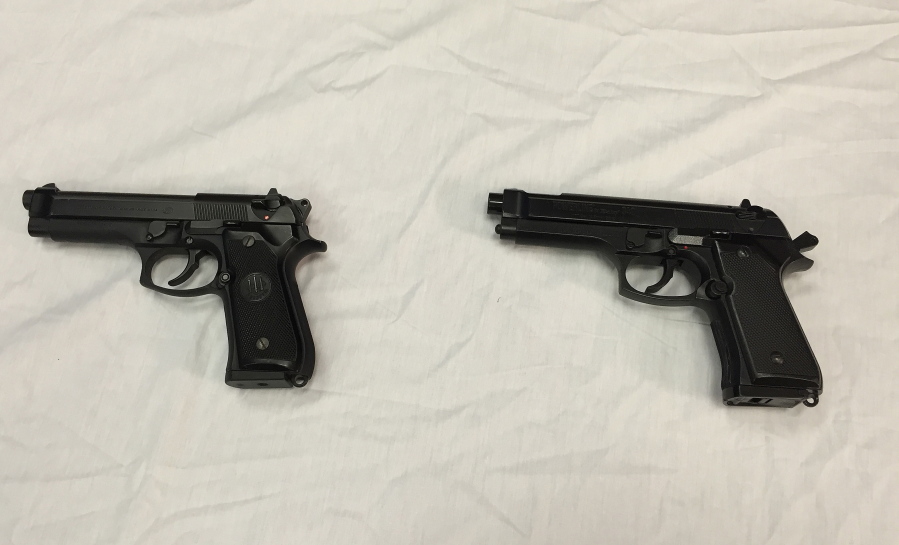Whether they shoot BBs, pellets, paintballs or nothing at all, imitation guns can be indistinguishable from the real thing — it’s one reason why some criminals gravitate toward them. Plus they’re cheap and easy to get.
As Ohio authorities investigate the fatal police shooting of a 13-year-old boy who officers said pulled a realistic-looking BB gun from his waistband, law enforcement agencies are grappling with the use of fake guns to commit very real crimes.
“If I can’t go get a real gun, it’s easier for me to waltz into Wal-Mart or whatever store sells these things and go get a replica. Because if I go to a store to hold it up, the guy behind the counter isn’t going to know it’s not real,” said Geoffrey Alpert, a criminal justice professor at the University of South Carolina.
While the federal government does not track criminals’ use of toy or replica guns, some individual police departments say they’ve noticed an uptick.
In Edmonton, Canada, police said imitation guns were involved in 1,598 incidents in 2015 — up 38 percent from a year earlier.
In Arlington, Texas, suspects are increasingly using lookalike guns, including an incident earlier this year in which a man carjacked a woman using an air gun that resembled a real pistol, and another case involving a teen who threatened an officer with a replica gun. The officer managed to knock it out of the teen’s hand and tackle him.
Arlington police Lt. Christopher Cook said that between March and August, nearly 20 percent of the weapons seized by police after they were used in crimes turned out to be lookalikes.
So far, police haven’t had to use deadly force. But Cook said that could change in an instant.
“There’s no training in the world that we know of where an officer can readily distinguish a real gun from a fake gun,” he said. “That’s not realistic, because officers have to make split-second decisions to ascertain whether it’s a firearm or not.”
A lookalike weapon is at the center of last week’s fatal police shooting of Tyre King in Columbus, Ohio.
An officer responding to a report of a $10 armed robbery shot the teen after he pulled out a BB gun that looked “practically identical” to the weapon that police officers use, Columbus police said.
A 19-year-old who said he was the boy’s friend told a newspaper that Tyre had a real-looking BB gun, was out to rob someone and ran from police. But an attorney for Tyre’s family has called for an independent investigation, saying the family believes the boy’s involvement in an armed robbery would be “out of character” and the police version of events “might not be true.”
However the facts shake loose in Columbus, the use of replica guns in crime has long vexed law enforcement.
In the late 1980s, after a rash of high-profile police shootings of suspects carrying toy or lookalike guns, Congress authorized a study that found thousands of robberies and assaults to have been committed with imitation weapons between 1985 and 1989. The study also identified more than 250 cases in which an officer used force — deadly or otherwise — on a suspect brandishing an imitation gun.
More recently, Associated Press research found at least 25 deaths involving lookalike guns mistaken by police for actual firearms across the country in the last two decades, dating to the 1994 slaying by a housing police officer of a 13-year-old New York City boy.
“It’s horrible, it’s horrible, when these kids are displaying these firearms and a life is lost, and after the fact it turns out it’s not real,” said Allentown, Pennsylvania, police Capt. Richard London.
But he added it can be nearly impossible to tell an imitation gun from a firearm that shoots real bullets.
“It’s human nature to defend yourself in the face of that,” he said.
At least 12 states, Washington, D.C., and Puerto Rico have laws restricting the sale or use of imitation firearms, according to the National Conference of State Legislatures, while many cities and towns have their own ordinances on lookalike guns.
Federal law requires imitation guns to have orange plugs in the barrel to distinguish them from real firearms, but the tips are easily removed and experts question their effectiveness.
——
Associated Press researcher Rhonda Shafner in New York contributed to this story.



